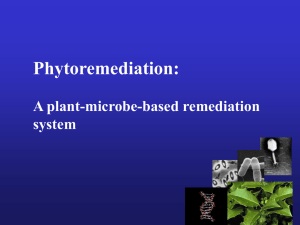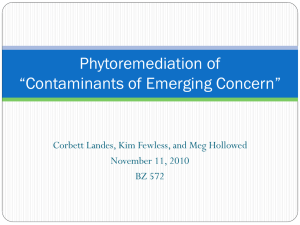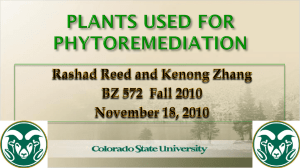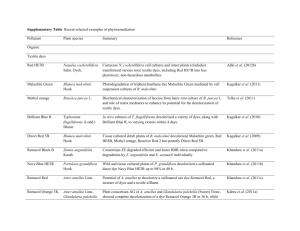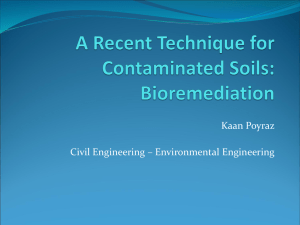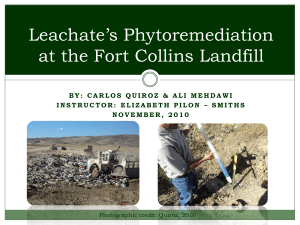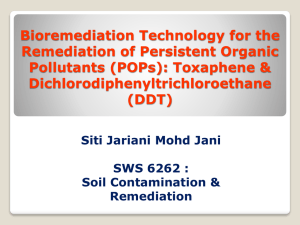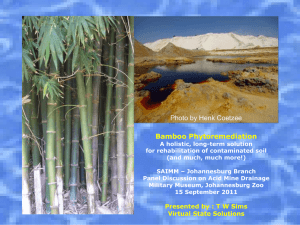phytointro
advertisement
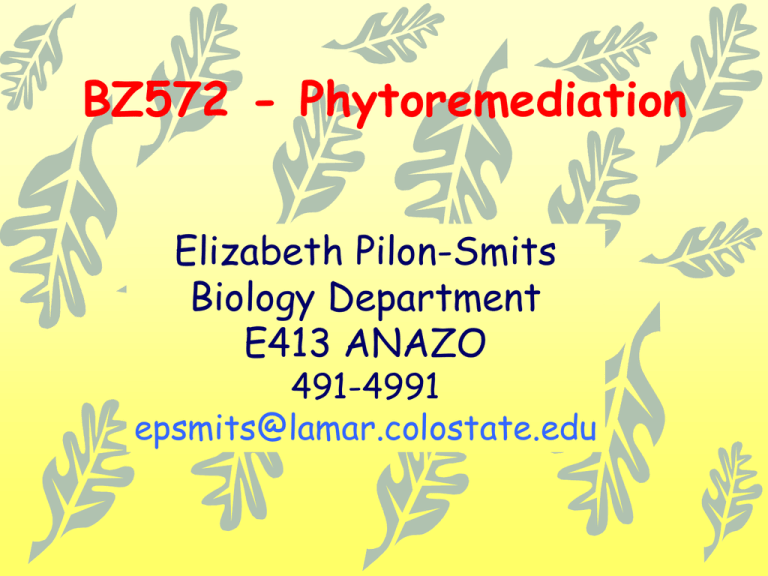
BZ572 - Phytoremediation Elizabeth Pilon-Smits Biology Department E413 ANAZO 491-4991 epsmits@lamar.colostate.edu Let’s hear from you Please write on piece of paper: • Degree, major/department, reg./auditing? • What is your career goal? • How does phytoremediation fit in? • Any particular aspects of phytoremediation you are most interested in? BZ572 – Course Info Text: webct No book, only papers from course website Topics: - Intro to phytoremediation - Phyto of inorganics*) - Phyto of organics*) - 1 Lab expt, 1 trip to a lab, 1 field trip (if interest), 5 guest lectures, in-class exercises, job info *) mechanisms of uptake, translocation, detoxification, effects of soil, microbes on remediation, approaches to enhance phyto efficiency, including genetic engineering Grading: Conventional, no curving Exams: 50% of total grade - 1 midterm + 1 final exam (not comprehensive) essay questions Term paper & presentation: 30% of grade - write web page/proposal/review + present In-class participation: 20% of grade - lab report, in-class group assignments, literature discussions Introduction to Phytoremediation • History • Status • Uses • Advantages • Limitations • Phytoremediation strategies History of phytoremediation • for centuries: wetlands used for waste treatment in Europe • last century: metal hyperaccumulator plants discovered - used as indicators for mining • 1970s: - clean water act, clean air act • 1980s: - superfund act (1986 - 8.5 billion $) - idea to use hyperaccumulator plants for metal cleanup (Chaney) History of phytoremediation (cont.) • 1994: phytoremediation term coined (Ilya Raskin) massive interest from gov. & industry - DOE phytorem. workshop - first phytorem. company (Phytotech) • 1995: first phytorem. conference phytoremediation takes off History of phytoremediation (cont.) •(Raskin) • 1994: Term phytoremediation first used • 1995: First phyto conference Columbia MO • 2000: EPA phyto conference • 2000: 1st phyto faculty positions • 2000: 1st phyto course (this one) • 2001, 2003: 1st, 2nd phyto call for proposals •(NSF/EPA/DOE) • 2000, 2001: 1st, 2nd professors in phyto •(U Mich, U S-Carolina) Status of phytoremediation • U.S. phytoremediation market (Glass, 1999, 2004 pers. comm.) 1999 2004 $ 30 - 49 million / yr $ 100-150 million / yr • World phytoremediation market 1999 $ 34 - 58 million • Total remediation market US: $ 6-8 billion/yr World: $ 25-50 billion/yr Status of phytoremediation (cont.) • 9 purely phytorem. companies • 7 constructed wetland companies • > 40 consulting/engin. companies that also do phytoremediation • ~200 field projects - funded mostly by EPA, DOD, DOE - some commercial/joint projects Uses of phytoremediation Remediation of different media: • • • • air soils, sediments groundwater wastewater streams - industrial - agricultural - municipal, sewage Uses of phytoremediation (cont.) Remediation of different pollutants: • inorganics: - metals (Pb, Cd, Zn, Cr, Hg) - metalloids (Se, As) - “nutrients” (K, P, N, S) - radionuclides (Cs, U) • organics: - PCBs - PAHs - TCE - TNT - MTBE - pesticides - petroleum hydrocarbons Etc. Uses of phytoremediation (cont.) Remediation using different systems: • farming polluted soil • irrigation with polluted groundwater • letting trees tap into groundwater • letting plants filter water streams constructed wetlands, hydroponics different systems: Hydraulic barrier different systems: • Vegetative cap different systems: • Constructed wetlands different systems: hydroponics with polluted wastewater Roots of mustard Extend into effluent Acting as filters for heavy metals Uses of phytoremediation (cont.) Remediation using different plants Properties of a good phytoremediator: • high tolerance to the pollutants • high biomass production, fast growth • large, deep root system • good accumulator/degrader of pollutant • able to compete with other species • economic value Uses of phytoremediation (cont.) Popular plants for phytoremediation • trees yellow poplar various organics metals gum tree poplar willow Uses of phytoremediation (cont.) Popular plants for phytoremediation (cont.): Brassicaceae: • For inorganics • grasses Thlaspi Alyssum Brassica juncea Uses of phytoremediation (cont.) Popular plants for phytoremediation (cont.): various grasses for organics hemp buffalo grass red fescue for inorganics kenaf bamboo Uses of phytoremediation (cont.) salicornia Popular plants for phytoremediation aquatic plants cattail parrot feather halophytes for inorganics for organics poplar, willow reed spartina Phytoremediation Solar energy In situ Fossil fuels for energy Ex situ Mechanical/chemical treatment • Soil washing • Excavation + reburial • Chemical cleanup of soil/water • Combustion Phytoremediation vs. Mechanical/chemical treatment Advantages of phytoremediation • Cheaper ~10 - 100x Excavation & reburial: up to $1 million/acre Revegetation: ~$20,000/acre Phytoremediation vs. Mechanical/chemical treatment Advantages of phytoremediation (cont.) • Less intrusive • Can be more permanent solution • Better public acceptance Phytoremediation vs. Mechanical/chemical treatment (cont.) Limitations of phytoremediation • Can be slower Limited by rate of biological processes -Accumulation in plant tissue: slow e.g. metals: average 15 yrs to clean up site - Filter action by plants: fast (days) - Metabolic breakdown (organics): fairly fast (< 1yr) Phytoremediation vs. Mechanical/chemical treatment (cont.) Limitations of phytoremediation (cont.) • Limited root depth Trees > prairie grasses > forbs, other grasses Max depth ~5 m Can be increased up to 20m with “deep planting” Phytoremediation vs. Mechanical/chemical treatment (cont.) Limitations of phytoremediation (cont.) • Plant tolerance to pollutant/conditions - Bigger problem with metals than organics - Can be alleviated using amendments, or treating hot spots by other method • Bioavailability of contaminant - Bioavailability can be enhanced by amendments So, when choose phytoremediation? • Sufficient time available • Pollution shallow enough • Pollutant concentrations not phytotoxic • $$ limited Note: Phyto may be used in conjunction with other remediation methods For very large quantities of mildly contaminated substrate: phytoremediation only cost-effective option Phytoremediation processes Phytoremediation processes phytostabilization • Phytostabilization: pollutant immobilized in soil - Metals - Non-bioavailable organics 1. Plants reduce leaching, erosion, runoff pollutant stays in place 2. Plants + microbes may transform pollutant to less bioavailable form (e.g. metal precipitation on roots) Phytoremediation processes phytostimulation • Phytostimulation: plant roots stimulate degradation of pollutant by rhizosphere microbes Organics e.g. PCBs, PAHs bacteria, fungi Phytoremediation processes phytodegradation • Phytodegradation: plants degrade pollutant, with/without uptake, translocation Via enzymes, e.g. oxygenases nitroreductase Certain organics e.g. TCE, TNT, atrazine in tissues or in root exudate Phytoremediation processes phytoextraction accumulation • Phytoextraction: pollutant accumulated in harvestable plant tissues mainly inorganics: metals metalloids radionuclides Plant biomass may be used (e.g. to mine metals, or non-food industrial use) or disposed after minimizing volume (incineration, composting) Phytoremediation processes phytovolatilization • Phytovolatilization: pollutant released in volatile form into the air some metal(loid)s: Se, As, Hg some volatile organics: TCE, MTBE Phytoremediation applications may involve multiple processes at once accumulation volatilization stabilization degradation Rhizofiltration water • Rhizofiltration: pollutant removed from water by plant roots in hydroponic system for inorganics metals metalloids radionuclides Plant roots & shoots harvestable (may be used to mine metals) or disposed after minimizing volume • Hydroponics for metal remediation: 75% of metals removed from mine drainage Rhizofiltration Involves: • phytoextraction • phytostabilization • Constructed wetland for Se remediation: 75% of Se removed from ag drainage water Involves: •phytoextraction • phytovolatilization • phytostabilization • (rhizofiltration) • (phytostimulation) • Natural attenuation: polluted site left alone but monitored • Vegetative cap: polluted site revegetated, then left alone, monitored with/without adding clean topsoil Hydraulic barrier Water flow redirected Pollutants intercepted H2O Phytoremediation project (1996-) (Phytokinetics inc.) Oregon site Soil polluted with PAHs Planted with grass (Lolium perenne) Results: bare soil: some PAH removal vegetated soil: increased PAH removal (~4x) Process? Phytostimulation/phytodegradation Phytoremediation project (1995-1998) (Phytotech inc.) New Jersey site Soil polluted with lead (Pb) Planted with Indian mustard (Brassica juncea) Results (after 3 growing seasons): bare soil: 6% reduction in Pb vegetated soil: 29% reduction in Pb Process? Phytoextraction Phytoremediation project (1997) (COE) Mississippi site Groundwater polluted with TNT pumped through constructed wetland Results: 95% reduction in TNT endogenous plant enzymes found to degrade TNT Process? Phytodegradation Some light reading: Print from Course Website •EPA: Citizen’s guide to Phytoremediation •EPA: Citizen’s guide to Natural Attenuation •Pilon-Smits, 2005 Phytoremediation (review) Ann Rev Plant Biology
